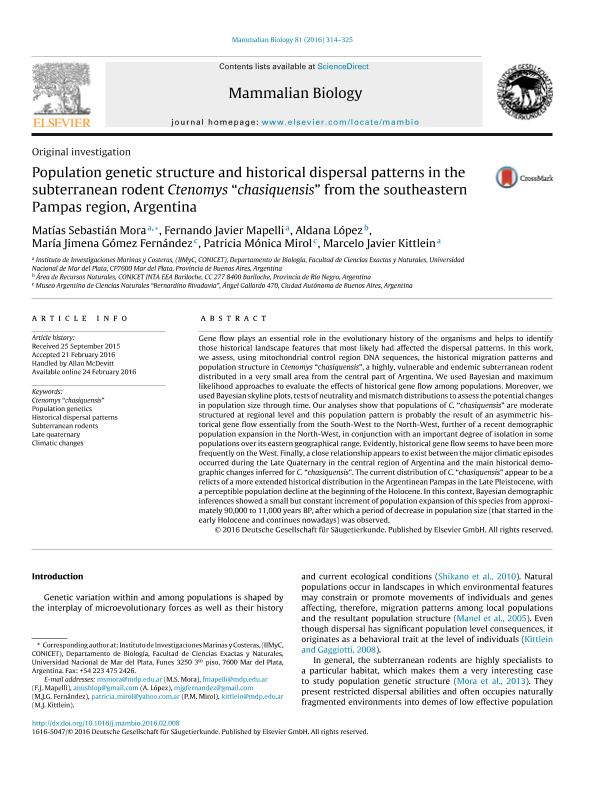Artículo
Population genetic structure and historical dispersal patterns in the subterranean rodent Ctenomys “chasiquensis” from the southeastern Pampas region, Argentina
Mora, Matias Sebastian ; Mapelli, Fernando Javier
; Mapelli, Fernando Javier ; López, Aldana Soledad
; López, Aldana Soledad ; Gomez Fernandez, Maria Jimena
; Gomez Fernandez, Maria Jimena ; Mirol, Patricia Monica
; Mirol, Patricia Monica ; Kittlein, Marcelo Javier
; Kittlein, Marcelo Javier
 ; Mapelli, Fernando Javier
; Mapelli, Fernando Javier ; López, Aldana Soledad
; López, Aldana Soledad ; Gomez Fernandez, Maria Jimena
; Gomez Fernandez, Maria Jimena ; Mirol, Patricia Monica
; Mirol, Patricia Monica ; Kittlein, Marcelo Javier
; Kittlein, Marcelo Javier
Fecha de publicación:
05/2016
Editorial:
Elsevier Gmbh
Revista:
Mammalian Biology
ISSN:
1616-5047
Idioma:
Inglés
Tipo de recurso:
Artículo publicado
Clasificación temática:
Resumen
Gene flow plays an essential role in the evolutionary history of the organisms and helps to identify those historical landscape features that most likely had affected the dispersal patterns. In this work, we assess, using mitochondrial control region DNA sequences, the historical migration patterns and population structure in Ctenomys “chasiquensis”, a highly, vulnerable and endemic subterranean rodent distributed in a very small area from the central part of Argentina. We used Bayesian and maximum likelihood approaches to evaluate the effects of historical gene flow among populations. Moreover, we used Bayesian skyline plots, tests of neutrality and mismatch distributions to assess the potential changes in population size through time. Our analyses show that populations of C. “chasiquensis” are moderate structured at regional level and this population pattern is probably the result of an asymmetric historical gene flow essentially from the South-West to the North-West, further of a recent demographic population expansion in the North-West, in conjunction with an important degree of isolation in some populations over its eastern geographical range. Evidently, historical gene flow seems to have been more frequently on the West. Finally, a close relationship appears to exist between the major climatic episodes occurred during the Late Quaternary in the central region of Argentina and the main historical demographic changes inferred for C. “chasiquensis”. The current distribution of C. “chasiquensis” appear to be a relicts of a more extended historical distribution in the Argentinean Pampas in the Late Pleistocene, with a perceptible population decline at the beginning of the Holocene. In this context, Bayesian demographic inferences showed a small but constant increment of population expansion of this species from approximately 90,000 to 11,000 years BP, after which a period of decrease in population size (that started in the early Holocene and continues nowadays) was observed.
Archivos asociados
Licencia
Identificadores
Colecciones
Articulos(IIMYC)
Articulos de INSTITUTO DE INVESTIGACIONES MARINAS Y COSTERAS
Articulos de INSTITUTO DE INVESTIGACIONES MARINAS Y COSTERAS
Articulos(MACNBR)
Articulos de MUSEO ARG.DE CS.NAT "BERNARDINO RIVADAVIA"
Articulos de MUSEO ARG.DE CS.NAT "BERNARDINO RIVADAVIA"
Citación
Mora, Matias Sebastian; Mapelli, Fernando Javier; López, Aldana Soledad; Gomez Fernandez, Maria Jimena; Mirol, Patricia Monica; et al.; Population genetic structure and historical dispersal patterns in the subterranean rodent Ctenomys “chasiquensis” from the southeastern Pampas region, Argentina; Elsevier Gmbh; Mammalian Biology; 81; 3; 5-2016; 314-325
Compartir
Altmétricas



